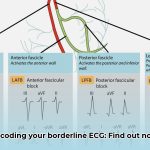Getting an electrocardiogram (ECG) result marked as “borderline” can understandably cause concern. It suggests the heart’s electrical activity shows some variations, prompting questions and the need for clarity. This guide will equip you with the knowledge to understand a borderline ECG, what the test measures, potential interpretations, follow-up steps, and the influence of lifestyle on heart health. Let’s work together to clarify any uncertainties you may have and empower you to better understand your heart health.
Understanding Borderline ECG Results
Receiving your electrocardiogram (ECG) results can be stressful, especially if the report indicates “borderline.” Let’s break down what this means: a borderline ECG suggests minor deviations from a completely normal heart rhythm, but it doesn’t automatically confirm a heart problem. It’s more accurate to consider it a signal for further investigation rather than a definitive diagnosis. These minor deviations aren’t always cause for alarm; they simply warrant a closer look to ensure everything is functioning correctly. What are the key indicators doctors focus on when interpreting a borderline ECG?
What Does a “Borderline” ECG Result Actually Mean?
Envision an ECG as a snapshot of your heart’s electrical activity, reflecting your heart rhythm. An ECG displaying a good heart rhythm reveals a stable and consistent pattern, like a steady drumbeat. Conversely, a borderline ECG might show minor glitches, which appear as slight variations in the timing or shape of the electrical signals. Although these minor changes aren’t always significant, healthcare providers should closely examine them to ensure everything is functioning correctly. In essence, a borderline ECG prompts healthcare providers to conduct additional assessments, effectively ruling out any underlying heart problems.
Key Areas Doctors Look At in a Borderline ECG
Doctors focus on specific sections when interpreting a borderline ECG tracing:
-
The QT Interval: This measures how long it takes your heart’s lower chambers (ventricles) to recharge between beats. An unusually long or short QT interval could be a sign of potential issues, depending on the overall cardiac picture. It’s not a definitive red flag in isolation.
-
The ST Segment: This part of the ECG indicates the beginning of ventricle contraction. Elevated or depressed ST segments beyond usual levels may signal a problem with blood flow to the heart muscle (ischemia).
-
The T Waves: These waves represent the heart muscle’s relaxation. Irregular shapes might suggest an electrolyte imbalance or reduced blood flow to the heart.
Remember: Interpreting these details requires a trained medical professional. Don’t attempt self-diagnosis. How do medical professionals integrate the above metrics in arriving at a diagnosis?
Understanding Borderline Findings: It’s All About Context
Doctors consider your medical history, symptoms, and lifestyle – not just numbers. For example, symptoms like chest pain, shortness of breath, or dizziness are important. A family history of heart problems and current stress levels also influences interpretation. These factors greatly affect the significance of subtle ECG variations. A minimal variation might be insignificant in one person but critical for another. Isn’t it reassuring to know that many factors go into assessing your heart health?
What Happens After You Get a Borderline ECG?
A borderline ECG often prompts more tests for a clearer picture. The specific tests depend on your case:
-
Stress Test: An exercise test (or medication-induced) to assess heart function under stress.
-
Echocardiogram: A type of ultrasound that creates images of your heart’s structure and function.
-
Holter Monitor: A portable ECG device that tracks your heart rhythm for 24-48 hours.
-
Blood Tests: These tests help check for electrolyte imbalances and other blood substances.
These follow-up tests help reach an accurate diagnosis and ensure appropriate treatment. According to the Mayo Clinic, ECGs are a valuable and effective way to capture insight in your heart’s overall health.
How Your Lifestyle Affects Your Heart Health and ECG Results
Your daily habits can impact your ECG readings. Healthy lifestyle choices can greatly boost your heart health, which could improve future ECG results. The American Heart Association (AHA) recommends at least 150 minutes per week of moderate-intensity aerobic activity or 75 minutes per week of vigorous aerobic activity.
-
Diet: Choose a balanced diet, low in saturated fats and salt.
-
Exercise: Regular physical activity strengthens your heart.
-
Stress Management: Chronic stress strains your cardiovascular system. Practice stress-reducing activities like exercise, meditation, or nature walks.
-
Smoking: Avoid smoking, as it significantly raises your risk of heart disease.
These lifestyle adjustments benefit your heart and overall well-being.
Understanding Your Risk: A Simplified View
The following table offers a basic view of risk factors linked to borderline ECG results. Your doctor will provide a more personalized assessment.
| Factor | Low Risk | Moderate Risk | High Risk |
|---|---|---|---|
| ECG Findings | Minor, isolated variations | Several variations; minor rhythm issues | Significant variations; concerning rhythm changes |
| Symptoms | None | Mild, nonspecific (fatigue, etc.) | Severe (chest pain, shortness of breath) |
| Medical History | No significant heart problems | Hypertension, high cholesterol | History of heart disease, arrhythmias |
| Lifestyle Factors | Healthy habits | Some unhealthy habits | Many significant risk factors (obesity, smoking) |
A doctor’s interpretation is crucial. Ask your doctor any questions. A borderline ECG doesn’t automatically signal critical issues; it indicates the need for further information to ensure optimal care. With proactive adjustments, the effectiveness of lifestyle changes has been proven to improve heart health.
How to Interpret Borderline ECG Results and Next Steps
- A borderline ECG isn’t a diagnosis but signals the need for further investigation.
- Understanding context – patient history and symptoms – is critical.
- Follow-up tests can offer clarity.
- Lifestyle adjustments can help improve heart health.
What Makes an ECG “Borderline”?
A borderline ECG serves as a clue, not the complete case file. It hints at potential issues with heart rhythm or electrical activity but remains inconclusive. These results neither confirm nor rule out a heart problem, often due to subtle electrical irregularities, interference, or natural variations in heart function.
Understanding Key ECG Features
Interpreting a borderline ECG requires attention to specific details within the tracing.
- QT Interval: Measures the time it takes for your heart’s ventricles to recharge. Prolonged or shortened intervals may suggest increased risk.
- ST Segment: Shows the heart muscle’s recovery after contraction. Slight elevation or depression warrants scrutiny, potentially signaling problems.
- T Wave: Represents the heart’s electrical repolarization. Changes here can signify electrolyte imbalances or underlying conditions.
These are subtle variations; a slight shift doesn’t automatically equate to a major health concern.
How to Interpret Borderline ECG Results and Next Steps: Examples & Implications
Consider a slightly prolonged QT interval. On its own, this is inconclusive. Is there a family history of long QT syndrome? Are you on medications that affect heart rhythm? These factors determine the next steps.
Another example: A small ST-segment depression might appear. Does it correlate with chest pain, shortness of breath, or other symptoms?
Navigating the Next Steps After a Borderline ECG
A borderline ECG necessitates a collaborative approach between you and your doctor.
Step 1: Discuss Your Results: Schedule a follow-up to review the report.
Step 2: Further Testing: Your doctor may recommend:
- Repeat ECG: To rule out technical errors or temporary influences.
- Holter Monitor: For a comprehensive view of heart activity over 24-48 hours.
- Echocardiogram: An ultrasound to measure your heart’s structure and function.
- Stress Test: To assess how your heart functions under stress, revealing potential problems not evident at rest.
- Event monitor: Similar to a Holter monitor, but worn for a longer period (e.g., 30 days) to capture intermittent abnormalities.
Step 3: Lifestyle Adjustments:
- Regular Exercise: Aim for 150 minutes of moderate-intensity aerobic activity weekly.
- Balanced Diet: Focus on fruits, vegetables, and whole grains, and limit saturated and trans fats.
- Stress Management: Incorporate relaxation techniques, like meditation, yoga, or spending time in nature.
- Smoking Cessation: Quitting smoking can significantly improve your heart health and overall well-being.
- Limit Alcohol Consumption: Excessive alcohol intake can negatively impact heart rhythm and blood pressure.
- Maintain a Healthy Weight: Obesity is a significant risk factor for heart disease.
Addressing Risk Factors & Long-Term Outlook
Identify and modify modifiable risk factors, as preventative measures are your greatest allies in long-term heart health. A proactive approach, involving regular check-ups and adherence to a healthy lifestyle, can significantly reduce the risk of developing heart problems.
This guide assists in navigating the complexities of a borderline ECG. While it doesn’t typically cause immediate alarm, it necessitates careful monitoring and potential follow-up to ensure optimal cardiac health.
Mastering Borderline ECG Interpretation for Specific Cardiac Conditions
- A borderline ECG isn’t a diagnosis; further investigation is
- How Much Do Wellness Programs Cost Businesses To Offer? - December 16, 2025
- Wellness Fair Ideas for Work to Boost Employee Wellbeing - December 15, 2025
- Affordable Employee Wellness Fair Ideas for Any Budget - December 14, 2025
















